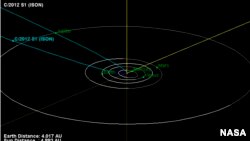NASA has captured the first images of a distant comet, which may give us a spectacular light show later this fall.
The images of comet C/2012 S1 (ISON), were taken by NASA’s Deep Impact spacecraft from January 17 and 18 when the comet was 493 million miles away, according to a NASA release.
"This is the fourth comet on which we have performed science observations and the farthest point from Earth from which we've tried to transmit data on a comet," said Tim Larson, project manager for the Deep Impact spacecraft at NASA's Jet Propulsion Laboratory in Pasadena, Calif. "The distance limits our bandwidth, so it's a little like communicating through a modem after being used to DSL. But we're going to coordinate our science collection and playback so we maximize our return on this potentially spectacular comet."
As comets approach, the sun’s energy warms them, releasing gas and dust which form a comet’s luminous tail. While ISON is still distant, NASA says it is already active, with a tail extending more than 40,000 miles form the comet’s nucleus. ISON is expected to come as close as 40 million miles to Earth on December 26 of this year.
ISON is known as a long-period comet. These can have orbits lasting hundred, thousands or even millions of years. NASA believes this is ISON’s first orbit, which means it is likely “laden with volatile material just spoiling for some of the sun's energy to heat it up and help it escape.” That could mean quite a show, but NASA cautions the comet could break up as well.
Would-be comets are thought to dwell in the solar system’s Oort cloud, something NASA calls a “giant spherical cloud of icy bodies surrounding our solar system so far away its outer edge.” When these bodies are disturbed by the gravitational effects of passing or nearby stars, they can be “nudged” from the cloud and begin their long orbits around the Sun.
ISON was discovered on Sept. 21, 2012, by two Russian astronomers using the International Scientific Optical Network's 16-inch (40-centimeter) telescope near Kislovodsk.
The images of comet C/2012 S1 (ISON), were taken by NASA’s Deep Impact spacecraft from January 17 and 18 when the comet was 493 million miles away, according to a NASA release.
"This is the fourth comet on which we have performed science observations and the farthest point from Earth from which we've tried to transmit data on a comet," said Tim Larson, project manager for the Deep Impact spacecraft at NASA's Jet Propulsion Laboratory in Pasadena, Calif. "The distance limits our bandwidth, so it's a little like communicating through a modem after being used to DSL. But we're going to coordinate our science collection and playback so we maximize our return on this potentially spectacular comet."
As comets approach, the sun’s energy warms them, releasing gas and dust which form a comet’s luminous tail. While ISON is still distant, NASA says it is already active, with a tail extending more than 40,000 miles form the comet’s nucleus. ISON is expected to come as close as 40 million miles to Earth on December 26 of this year.
ISON is known as a long-period comet. These can have orbits lasting hundred, thousands or even millions of years. NASA believes this is ISON’s first orbit, which means it is likely “laden with volatile material just spoiling for some of the sun's energy to heat it up and help it escape.” That could mean quite a show, but NASA cautions the comet could break up as well.
Would-be comets are thought to dwell in the solar system’s Oort cloud, something NASA calls a “giant spherical cloud of icy bodies surrounding our solar system so far away its outer edge.” When these bodies are disturbed by the gravitational effects of passing or nearby stars, they can be “nudged” from the cloud and begin their long orbits around the Sun.
ISON was discovered on Sept. 21, 2012, by two Russian astronomers using the International Scientific Optical Network's 16-inch (40-centimeter) telescope near Kislovodsk.







